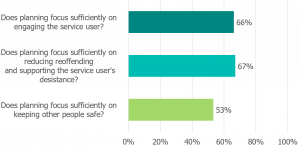Planning

Key findings
- Optimal plans tend to be realistic but appropriately challenging, recognising that the service user may have multiple complex needs that cannot sensibly be addressed all at once.
- Overall, studies report more benefits in cases where practitioners draw up plans in collaboration with the service user, respect and foster their personal agency, focus on strengths as well as needs and risks, and target motivational factors. Service users are then more likely to fully engage and have a direct investment in achieving the agreed outcomes.
- In some cases, plans need to include interventions designed to minimise the risk of harm presented to other people. Ideally the individual should be aware of the plans and should be actively involved in monitoring and managing their own risk.
Background
Supervision should be put into effect in a planned way. There must be a strong and natural connection between assessment and planning, with the planning process setting out what is to be done about the needs identified and how to develop and utilise the service user’s personal strengths and skills.
Modern (fourth generation) assessment tools, such as the Offender Assessment System (OASys) tool, integrate assessment and planning to assist with their alignment.
Summary of the evidence
Tailoring objectives
Research findings demonstrate the importance of services and interventions being multi-modal, holistic and sequenced. At the planning stage, practitioners need a good understanding of the resources and services available, with other agencies being involved where necessary to assist with the necessary joining-up. The service user may have multiple complex needs that cannot sensibly be tackled all at once and they may disengage if the plan is over-ambitious. Plans may therefore need to be broken down into a smaller number of ‘steps’ with realistic, short-term objectives, recognising the distinction between stable and acute risk factors, and giving sufficient attention to potential practical obstacles to desistance. The optimal plans tend to be realistic but appropriately challenging.
The objectives should also be specific and measurable, so that progress can be monitored as part of the reviewing process.
Engaging the service user
As with assessment, a plan that the service user does not sufficiently understand or agree with is unlikely to be implemented. Overall, studies report more benefits in cases where practitioners draw up plans in collaboration with the service user, respect and foster their personal agency, focus on strengths as well as needs and risks, and target motivational factors. Service users are then more likely to fully engage and have a direct investment in achieving the agreed outcomes. Practitioners should thus make efforts to engage the service user as an active participant and help them to set goals towards desistance. Where the service user has misgivings about some of the plans proposed, this should be acknowledged and considered.
In some cases, plans need to include interventions designed to minimise the risk of harm that the service user may present to other people. Ideally the individual should be aware of the plans and should be actively involved in monitoring and managing their own risk. However, in some situations, aspects of the plan cannot appropriately be shared with the service user, or the individual may deny the risk they present, or may not wish to engage. In these circumstances, there should still be a proportionate, defensible and recorded plan to manage the risk.
The findings below are from our full round of probation inspections conducted between June 2018 and June 2019. We examined over 3,000 cases, with our inspectors considering whether there was sufficient focus within planning on engagement, desistance, and keeping other people safe.

Hughes W. (2012) ‘Promoting offender engagement and compliance in sentence planning: Practitioner and service user perspectives in Hertfordshire’, Probation Journal, 59(1), pp. 49-65.



